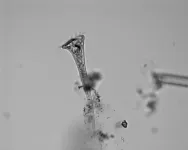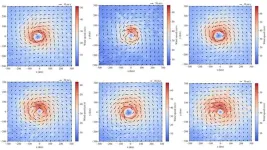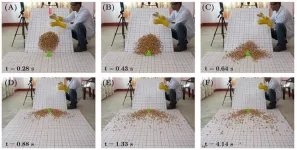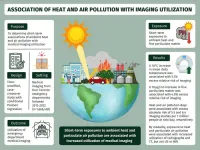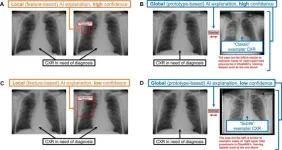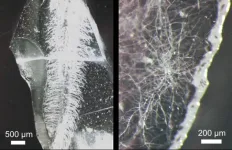Brain aging and Alzheimer's: Insights from non-human primates
“Brain aging is a biological process that comprehends degenerative, adaptive, and regenerative brain changes that elapse through maturity until the elderly.”
2024-11-19
(Press-News.org)
“Brain aging is a biological process that comprehends degenerative, adaptive, and regenerative brain changes that elapse through maturity until the elderly.”
BUFFALO, NY- November 19, 2024 – A new review was published in Aging (listed by MEDLINE/PubMed as "Aging (Albany NY)" and "Aging-US" by Web of Science), on October 29, 2024, Volume 16, Issue 20, titled, ”Brain aging and Alzheimer’s disease, a perspective from non-human primates.“
In the review, Ferrer Isidro from the University of Barcelona and Reial Acadèmia de Medicina de Catalunya, explores the differences in brain aging and Alzheimer’s disease between humans and their closest evolutionary relatives, such as chimpanzees, baboons, and macaques. The study highlights that while humans are uniquely susceptible to severe cognitive decline and memory loss caused by Alzheimer’s disease, non-human primates typically experience only mild changes as they age.
Alzheimer’s affects over 50 million people worldwide, making it crucial to understand how aging impacts the brain. This review sheds light on the differences between humans and non-human primates and reveals that while brain aging in primates involves some structural and protein changes, it does not result in the toxic protein deposits that drive Alzheimer’s in humans.
In humans, harmful tau protein deposits, known as tau tangles, appear early in life and spread widely through the brain, which damages cells and contributes to memory loss. In non-human primates, tau tangles are rare and typically confined to small regions. While primates may develop beta-amyloid deposits—fragments derived from amyloid precursor protein—these deposits are less toxic and do not interact with tau tangles to trigger Alzheimer’s-like symptoms. Aging primates experience only mild memory or behavioral changes, avoiding the severe cognitive decline and dementia often seen in humans.
Humans’ unique vulnerability to Alzheimer’s may be linked to traits that emerged through evolution, including larger brains, longer lifespans, and higher cognitive abilities. These adaptations may have come at a cost, making human brains more susceptible to aging-related damage.
This review also suggests that tau tangles play a more critical role in Alzheimer’s progression than previously thought. While traditional treatments focus on targeting beta-amyloid deposits, this research highlights the need to shift attention to tau pathology. The work challenges the widely accepted amyloid cascade hypothesis, which suggests that beta-amyloid is the main driver of Alzheimer’s. Instead, it points to tau tangles as the initial and most damaging change in human brains. This insight could encourage new treatments that focus on preventing or reducing tau deposits.
The findings also emphasize the value of studying non-human primates to understand why their brains are more resistant to severe aging-related damage. By identifying protective mechanisms in primates, researchers may discover new strategies to delay or prevent Alzheimer’s in humans.
“These observations show that human brain aging differs from brain aging in non-human primates, and humans constitute the exception among primates in terms of severity and extent of brain aging damage.”
In conclusion, this review not only improves our understanding of why humans are uniquely vulnerable to Alzheimer’s disease but also opens new avenues for exploring innovative strategies to combat aging-related brain damage in humans.
Read the full paper: DOI: https://doi.org/10.18632/aging.206143
Corresponding author: Ferrer Isidro - 8082ifa@gmail.com
Keywords: aging, brain aging, macaques, baboon, chimpanzees, orang-utans
Click here to sign up for free Altmetric alerts about this article.
About Aging:
The journal Aging aims to promote 1) treatment of age-related diseases by slowing down aging, 2) validation of anti-aging drugs by treating age-related diseases, and 3) prevention of cancer by inhibiting aging. (Cancer and COVID-19 are age-related diseases.)
Aging is indexed by PubMed/Medline (abbreviated as “Aging (Albany NY)”), PubMed Central, Web of Science: Science Citation Index Expanded (abbreviated as “Aging‐US” and listed in the Cell Biology and Geriatrics & Gerontology categories), Scopus (abbreviated as “Aging” and listed in the Cell Biology and Aging categories), Biological Abstracts, BIOSIS Previews, EMBASE, META (Chan Zuckerberg Initiative) (2018-2022), and Dimensions (Digital Science).
Please visit our website at www.Aging-US.com and connect with us:
Facebook
X
Instagram
YouTube
LinkedIn
Reddit
Pinterest
Spotify, and available wherever you listen to podcasts
Click here to subscribe to Aging publication updates.
For media inquiries, please contact media@impactjournals.com.
Aging (Aging-US) Journal Office
6666 E. Quaker St., Suite 1
Orchard Park, NY 14127
Phone: 1-800-922-0957, option 1
END
[Attachments] See images for this press release:
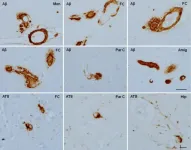
ELSE PRESS RELEASES FROM THIS DATE:
2024-11-19
Individual cells appear capable of learning, a behaviour once deemed exclusive to animals with brains and complex nervous systems, according to the findings of a new study led by researchers at the Centre for Genomic Regulation (CRG) in Barcelona and Harvard Medical School in Boston.
The findings, published today in the journal Current Biology, could represent an important shift in how we view the fundamental units of life.
“Rather than following pre-programmed genetic instructions, cells are elevated to entities equipped ...
2024-11-19
A dog learns to sit on command, a person hears and eventually tunes out the hum of a washing machine while reading … The capacity to learn and adapt is central to evolution and, indeed, survival.
Habituation — adaptation’s less-glamorous sibling — involves the lessening response to a stimulus after repeated exposure. Think the need for a third espresso to maintain the same level of concentration you once achieved with a single shot.
Up until recently, habituation — a simple form of learning — was deemed ...
2024-11-19
Viruses are lean, mean, infection machines. Their genomes are tiny, usually limited to a handful of absolutely essential genes, and they shed extra genomic deadweight extremely fast.
Usually.
Coronaviruses, including SARS-CoV-2 (the virus that causes COVID-19), appear at first glance to be an exception. They have some extra “accessory” genes in addition to the usual minimal viral set, and scientists don’t know what most of them do. Scientists believe these extra genes must be doing something important, though, or they would be rapidly lost as the viruses evolved.
Now, University of Utah Health researchers have found that some of these viral genes have stuck around ...
2024-11-19
WASHINGTON, Nov. 19, 2024 – Hurricanes, or tropical cyclones, can be devastating natural disasters, leveling entire cities and claiming hundreds or thousands of lives. A key aspect of their destructive potential is their unpredictability. Hurricanes are complex weather phenomena, and how strong one will be or where it will make landfall is difficult to estimate.
In a paper published this week in Physics of Fluids, by AIP Publishing, a pair of researchers from the City University of Hong Kong employed machine learning to more accurately model the boundary layer wind field of tropical cyclones.
In atmospheric science, the boundary layer ...
2024-11-19
WASHINGTON, Nov 19, 2024 – Champatis, the seeds of the Lapsi tree, are valued in Nepal for their medical, economic, social, and cultural significance. They are also popular among children as simple playthings. But for a group of physicists, these unique seeds—and the way they bounce and roll down slopes—could help them better understand landslides and avalanches, leading to research that could save lives.
In a study published this week in Physics of Fluids, by AIP Publishing, a team ...
2024-11-19
About The Study: In this cohort study of adults with outpatient medically attended-respiratory syncytial virus (RSV) infections from 3 large deidentified U.S. databases across 6 RSV seasons, approximately 1 in 20 adults experienced all-cause hospitalization within 28 days. The results of this study highlight the public health need for RSV prevention and treatment.
Corresponding Author: To contact the corresponding author, Joshua T. Swan, PharmD, MPH, email swan.joshua@gmail.com.
To access the embargoed study: Visit our For The Media ...
2024-11-19
In recent years, employers across North America have introduced or boosted equity, diversity and inclusion (EDI) programs in hopes of creating a more diverse and inclusive workplace culture.
But studies have shown that fostering diversity can come with a steep cost, as employees from dominant groups often felt threatened, leading to a backlash against the very groups the employers are seeking to support.
But could those feelings of threat also lead to learning and change, and eventually allyship? ...
2024-11-19
OAK BROOK, Ill. – Using data collected over a 10-year period from four emergency departments, researchers at the University of Toronto found that short-term exposure to ambient heat and air pollution levels was associated with increased utilization of X-rays and computed tomography (CT). Results of the study were published today in Radiology, a journal of the Radiological Society of North America (RSNA).
“Extreme climate exposures are associated with higher demand for health care including emergency department visits,” ...
2024-11-19
OAK BROOK, Ill. – When making diagnostic decisions, radiologists and other physicians may rely too much on artificial intelligence (AI) when it points out a specific area of interest in an X-ray, according to a study published today in Radiology, a journal of the Radiological Society of North America (RSNA).
“As of 2022, 190 radiology AI software programs were approved by the U.S. Food and Drug Administration,” said one of the study’s senior authors, Paul H. Yi, M.D., director of intelligent imaging informatics and associate member in ...
2024-11-19
Fukuoka, Japan— Microfluidic technology has become increasingly important in many scientific fields such as regenerative medicine, microelectronics, and environmental science. However, conventional microfabrication techniques face limitations in scale and in the construction of complex networks. These hurdles are compounded when it comes to building more intricate 3D microfluidic networks.
Now, researchers from Kyushu University have developed a new and convenient technique for building such complex 3D microfluidic networks. Their tool? Plants and fungi. The team developed a ‘soil’ medium using nanoparticles of glass (silica) and a cellulose ...
LAST 30 PRESS RELEASES:
[Press-News.org] Brain aging and Alzheimer's: Insights from non-human primates
“Brain aging is a biological process that comprehends degenerative, adaptive, and regenerative brain changes that elapse through maturity until the elderly.”

